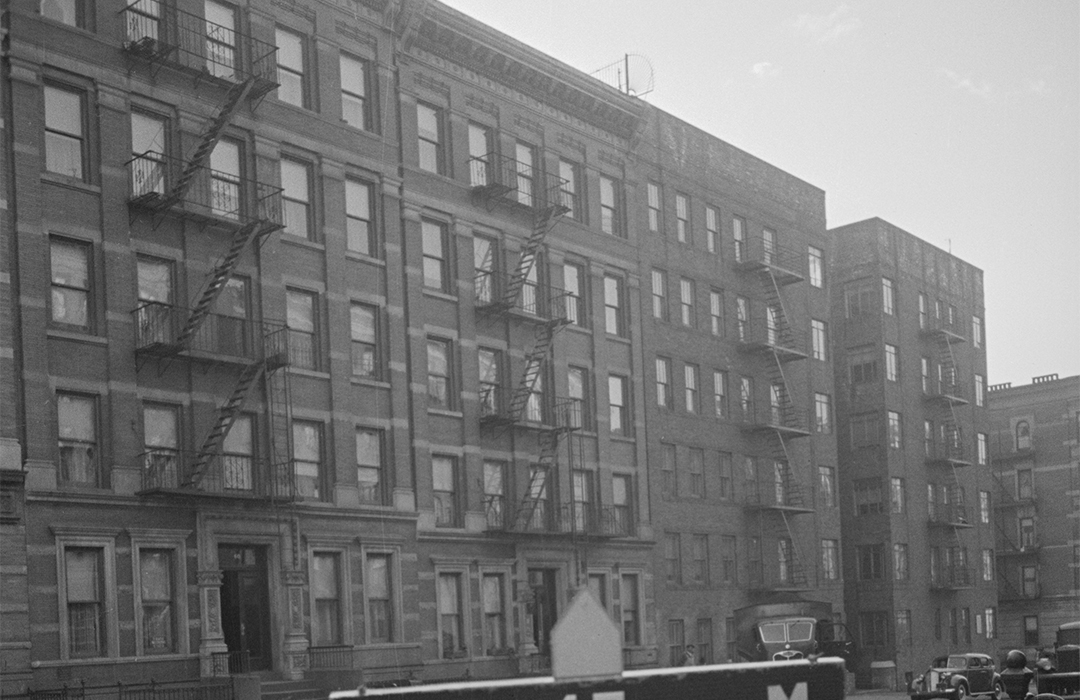
58 Manhattan Ave.
by Tom Miller
In 1895-96, developer Nicholas Cotter filled the northeastern half of Manhattan Avenue between 102nd and 103rd Streets with three five-story-and-basement apartment buildings. Designed by John C. Burne, the two interior buildings—58 and 60 Manhattan Avenue—were essentially identical. While Burne drew from the Italian Renaissance in designing the entrances, the buff Roman brick upper floors were neo-Grec in style. The stoic façades were relieved by bands of stone and capitals atop the three-story piers of the midsection. The otherwise-brooding design turned ebullient with the ornate, bracketed cornices and their decorative friezes.
No. 58 Manhattan Avenue, which held 20 apartments, cost Cotter $25,000 to erect (about $936,000 in 2025 terms). Each of the middle-class families here would have at least one servant. One of the first placed an advertisement in The World on September 3, 1896, that read, “Housework—Good, reliable girl for general housework. Call 10 to 1 o’clock, 58 Manhattan ave.”
Among the tenants at the turn of the century was attorney John Murtha. A story in the New-York Tribune in February 1900 drew his wrath. The Krapnitzky family, who lived in Brooklyn, were “poor,” according to the newspaper. In 1895, their 10-year-old daughter, Rachel, lost her hearing. Now, five years later, her mother visited a Christian Scientist named Lewis in Manhattan for help. He promised her he could restore the teen’s hearing in nine treatments for $1 each. According to Rachel, “on her visits to Manhattan she was taken into a small room and told to pray. Several prayers were written for her, and she was told to take them home and learn them.”
Dr. Womack intercepted as many of the letters as he could; but he missed one important one.
After five visits, Mrs. Krapnitzky refused to allow Rachel to go back. The girl “would do nothing but pray from the beginning to the end of the day,” explained the New-York Tribune. “She refused to eat and became emaciated and hollow eyed.” Finally, on March 2, 1900, Rachel was committed to the Kings County Asylum for the Insane. Indignant, John Murtha contacted the district attorney “in regard to this class of healers.” He told the New-York Tribune that “he will try to take legal action against the Christian Scientists.”
The names of the tenants of 58 Manhattan Avenue normally appeared in newsprint for social or professional reasons. Mrs. E. L. Earle, was an active member of the West End Woman’s Republican Club; George F. Spillmann was appointed a guard in the Sheriff’s Department on January 21, 1901; and James Fred Barber graduated with a law degree from Columbia in 1909, for instance.
Hattie Hull’s story, however, was much more salacious. She was born Hattie Womack in Chattanooga, the daughter of a well-known doctor. In 1905, she sent her photograph to a drug company that was advertising a hair tonic, hoping to land a modeling job. It drew the attention of artist Frank Hull, who wrote back. Dr. Womack intercepted as many of the letters as he could; but he missed one important one. In it, Hull asked Hattie to come to New York City and marry him. She did, and the two were married in the West End Presbyterian Church on Amsterdam Avenue and took an apartment at 58 Manhattan Avenue. Not surprisingly, according to The New York Sun, “they didn’t get along very well.”
Hattie began haunting the “cafes” (or nightclubs) where she struck up a friendship with Agnes Young. Hattie told a reporter that Frank Hull, “objected to Mrs. Young because he thought she drank more Martini cocktails than was good for a woman.” The newspaper said, “He told his wife she would have to cut Agnes Young’s acquaintance.” Instead, the women’s relationship grew stronger, and they frequented the night spots together, often finding male companionship.
The final rift between the Hulls came in 1906. The Sun explained, “not having a baby of her own, Mrs. Hull bought one for $7 from a woman named Keller.” (Hattie said that Mrs. Hull previously “had to spend a little time behind bars.”) Frank Hull was so angry about the baby that they parted ways. A year later, Hattie mused, “Anyway, the baby died. Just as well, I guess.”
James Fred Barber had to put his law practice on hold when he was drafted into the United States Army in 1918. Following the war, he returned to 58 Manhattan Avenue and to his practice.
Louise Margareth Vichl lived here in 1922 when the 44-year-old finally found love–or at least financial security with 74-year-old architect Justus R. Smith. A veteran of the Civil War, he and Louise were married on August 4 that year. The Brooklyn Standard Union said that his three previous wives had died. The autumn-summer marriage apparently started off romantically. The New York Herald reported, “Mr. Smith and his bride…left immediately after the ceremony and could not be found yesterday. Their relatives said they did not know where they had gone.”
Wolf bet Cohen $200 that he could not sell 100 50-cent coins for a quarter within 15 minutes.
Twenty-seven-year-old resident Jack Cohen was arrested on November 28, 1922. It all started when a shoe salesman friend from Missouri, Bill Wolf, was having a hard time making a sale. That morning, said Cohen, Wolf complained:
These New Yorkers is all hard-boiled, ten-minute eggs. You couldn’t sell ‘em tickets for the landing of the Pilgrim Fathers with an original cast. They wouldn’t pay a nickel to see George Washington tell a lie, and that’s what I think of them.
The two argued for a few seconds, then Wolf bet Cohen $200 that he could not sell 100 50-cent coins for a quarter within 15 minutes. And so, Cohen went to a bank, drew out 100 half-dollar coins, and placed them into individual envelopes marked “Blind Bargain.” He then mixed into the rush hour crowd, offering the 50-cent bargains at 25 cents. The New York Evening Call reported, “Plenty of folks heard him, but no one seemed to notice—except one. He was the cop who arrested him.”
In the courtroom, Cohen pleaded, “Well, judge, I’m sticking up for the old town, see? Because I think it’s all right. As far as I’m concerned, New York is the cat’s whiskers, see?” Cohen’s ploy to defend his city cost him a $2 fine—which he paid with four of the half-dollar coins.
A century later, there are still 20 apartments in 58 Manhattan Avenue. Other than a chocolate-colored coat of paint on the stone base and replacement windows, it survives essentially unchanged.
Tom Miller is a social historian and blogger at daytoninmanhattan.blogspot.com


